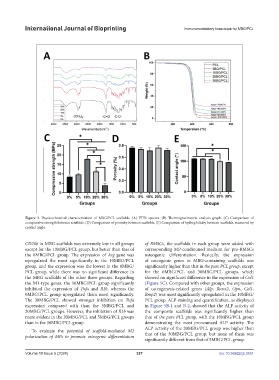Page 335 - IJB-10-5
P. 335
International Journal of Bioprinting Immunomodulatory bone repair by MBG/PCL
Figure 3. Physicochemical characterization of MBG/PCL scaffolds. (A) FTIR spectra. (B) Thermogravimetric analysis graph. (C) Comparison of
compressive strength between scaffolds. (D) Comparison of porosity between scaffolds. (E) Comparison of hydrophilicity between scaffolds, measured by
contact angle.
CD206 in MBG scaffolds was extremely low in all groups of BMSCs, the scaffolds in each group were added with
except for the 10MBG/PCL group, but better than that of corresponding MP-conditioned medium for pro-BMSCs
the 0MBG/PCL group. The expression of Arg gene was osteogenic differentiation. Basically, the expression
upregulated the most significantly in the 10MBG/PCL of osteogenic genes in MBG-containing scaffolds was
group, and the expression was the lowest in the 0MBG/ significantly higher than that in the pure PCL group, except
PCL group, while there was no significant difference in for the 0MBG/PCL and 30MBG/PCL groups, which
the MBG scaffolds of the other three groups. Regarding showed no significant difference in the expression of Col1
the M1-type genes, the 10MBG/PCL group significantly (Figure 5C). Compared with other groups, the expression
inhibited the expression of Tnfa and Il1b, whereas the of osteogenesis-related genes (Alp, Runx2, Opn, Col1,
0MBG/PCL group upregulated them most significantly. Bmp2) was most significantly upregulated in the 10MBG/
The 30MBG/PCL showed stronger inhibition on Tnfa PCL group. ALP staining and quantification, as displayed
expression compared with than the 5MBG/PCL and in Figure 5B-1 and B-2, showed that the ALP activity of
20MBG/PCL groups. However, the inhibition of Il1b was the composite scaffolds was significantly higher than
more evident in the 20MBG/PCL and 5MBG/PCL groups that of the pure PCL group, with the 10MBG/PCL group
than in the 30MBG/PCL group. demonstrating the most pronounced ALP activity. The
To evaluate the potential of scaffold-mediated M2 ALP activity of the 20MBG/PCL group was higher than
polarization of MPs to promote osteogenic differentiation that of the 30MBG/PCL group, but none of them was
significantly different from that of 5MBG/PCL group.
Volume 10 Issue 5 (2024) 327 doi: 10.36922/ijb.3551

